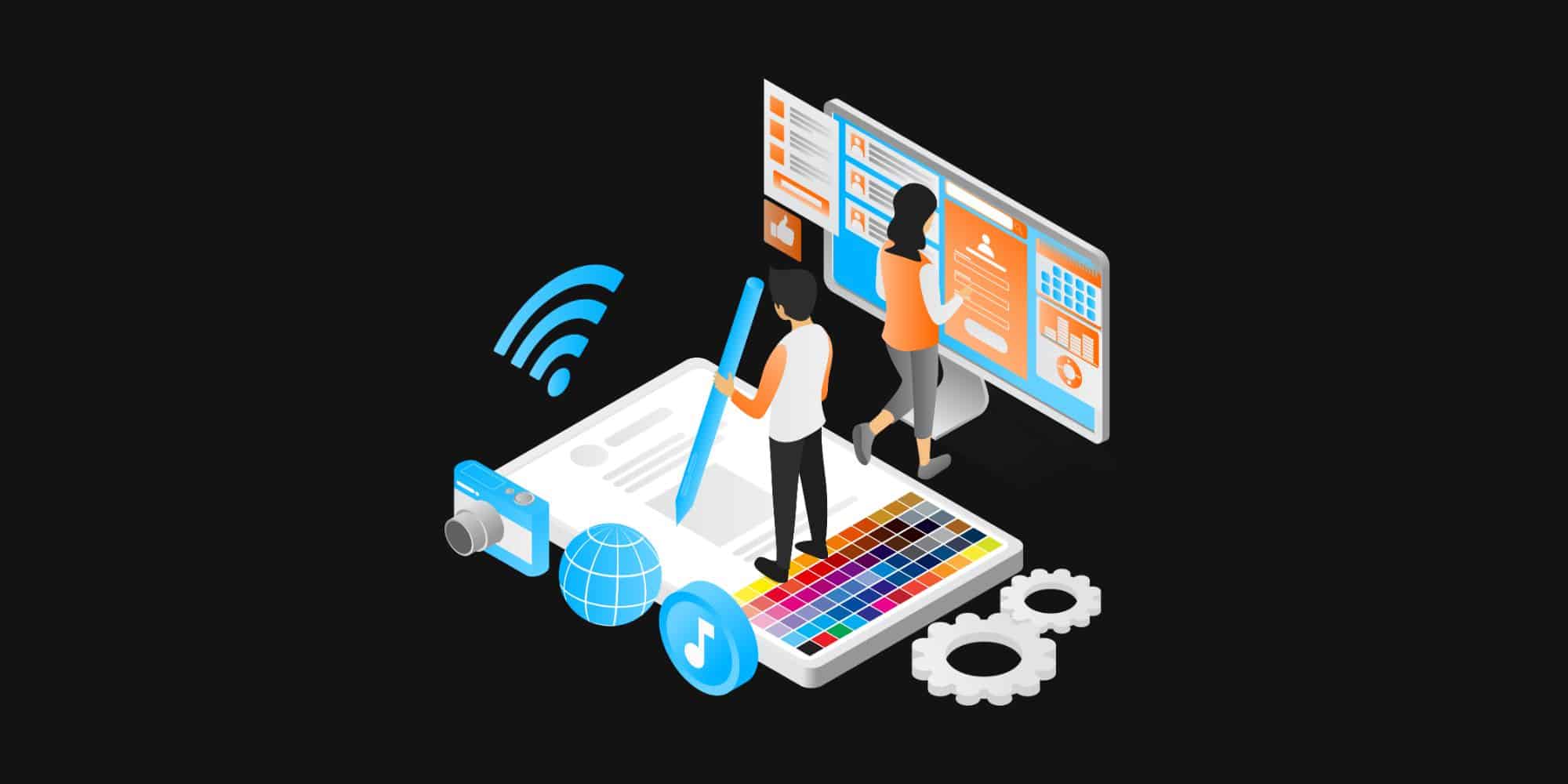When navigating the ever-evolving world of web design, it’s essential to differentiate between UI and UX, as they play distinct yet complementary roles in digital products. A user interface (UI) design focuses on the visual elements such as buttons, icons, and the overall aesthetic of a website or app. User experience (UX) design delves into the overall interaction users have with a product, ensuring their journey is intuitive, satisfying, and fulfilling. Understanding these components can elevate your approach to digital creation, offering a seamless and engaging experience for users.
A UI/UX designer’s job is to balance the interplay between aesthetics and functionality. This means not only crafting visually appealing interfaces but also considering how each element contributes to an effortless user journey. These roles demand constant collaboration between teams, but your ability to integrate these aspects into a cohesive design significantly impacts how a user interacts with your digital product.
Engaging users with both UI and UX elements in web design requires attention to both immediate visual attraction and long-term usability. By prioritizing both the look and feel alongside ease of use, you can make a lasting impression that not only captures attention but retains it. Your expertise in these design principles is key to creating digital products that users find both beautiful and practical.
Understanding UI and UX Web Design
UI and UX are essential components of web design, focusing on different aspects to create a seamless and engaging user experience. While UI design emphasizes the aesthetics and usability of user interfaces, UX design concentrates on the overall interaction and satisfaction of users. Understanding these aspects is crucial for creating intuitive and effective digital products.
The Difference Between UI and UX
UI Design represents the look and feel of a digital product. It covers elements such as buttons, icons, spacing, and color schemes. A UI designer’s goal is to create an interface that is visually appealing and easy to navigate.
UX Design, on the other hand, involves crafting a meaningful experience for the user. It includes aspects such as usability, information architecture, and customer journey mapping. UX design focuses on ensuring that users find value in what you provide.
Although UI and UX work closely together, they serve distinct purposes. While UI provides the product’s appearance, UX enhances the product’s usability and impact. A cohesive approach is necessary for success, as the visuals alone are insufficient without a satisfying user experience.
Core Principles of UI/UX Design
UI/UX design centers on key principles that guide the creation of successful digital experiences. Usability is fundamental; interfaces must be intuitive and straightforward, allowing users to achieve their objectives with ease.
Interactivity is another crucial element. Designs should engage users, encouraging exploration and interaction. UI/UX designers employ feedback mechanisms such as animations or sounds to reinforce interactions.
Accessibility cannot be overlooked. A well-designed interface is inclusive, accommodating users with varying abilities. This means providing textual alternatives to visual content, keyboard navigability, and readability enhancements. These principles work in harmony to ensure that the product not only looks appealing but also functions seamlessly.
Evolution of Web Design Practices
Web design practices have evolved significantly over the years. In the past, designers focused primarily on aesthetics, prioritizing visuals over functionality. As user expectations grew, the field embraced a more user-centered approach.
Responsive design emerged, allowing interfaces to adapt seamlessly across different devices and screen sizes. This flexibility is a cornerstone of modern UI/UX design. Web design now prioritizes consistency and performance, ensuring smooth interactions regardless of platform.
The rise of mobile technology further influenced design trends, driving the need for minimalist interfaces that load quickly and efficiently. Today’s designs are streamlined and functional, offering a balance between form and function that meets contemporary user needs.
The Design Process
Understanding the design process is crucial for creating effective user interfaces and experiences. This section covers the journey from initial concepts to testing, highlighting key practices like prototyping and user testing.
Conceptualizing the User Experience
The initial stage in the design process involves conceptualizing the user experience. This means identifying user needs, preferences, and behaviors, ensuring the final design will meet these expectations effectively. Keywords like user personas and journey maps often come into play.
Creating user personas helps you understand your audience, allowing more targeted design choices. Journey maps provide a visual representation of the user interactions, helping you identify touchpoints and areas for improvement. These tools guide your process and establish a user-focused foundation.
Creating Prototypes and Wireframes
Prototyping is a critical step in transforming ideas into tangible designs. It moves concepts from sketches to interactive models, enabling you to visualize and refine the design. Starting with low-fidelity wireframes helps with establishing structure and layout.
As the process progresses, high-fidelity wireframes offer more detail and include elements like typography and color schemes. Creating prototypes bridges the gap between static wireframes and dynamic experiences, allowing stakeholders to interact with and provide feedback on the design.
Design Testing and Iteration
Design testing is essential to ensure the user interface works as intended. It often involves user testing sessions, where real users interact with the product to identify usability issues or pain points. This phase helps refine and perfect the design through direct feedback.
Iteration is a continuous cycle where prototypes are adjusted based on test results. Revisiting the design based on user feedback is crucial for maintaining relevance and effectiveness. Through systematic testing and iteration, your design evolves to meet user needs more effectively.

Design Tools and Software
When selecting design tools and software, it’s crucial to identify options that improve workflow efficiency and enable the creation of innovative, responsive interfaces. This involves understanding both the individual tools available and the frameworks that help ensure your designs remain adaptable across different devices.
Popular UI/UX Design Tools
Choosing the right tool can streamline your design process and enhance collaboration. Figma is a key player, known for its collaborative capabilities, enabling teams to design, prototype, and gather feedback in real-time. It’s ideal for creating interactive prototypes and offers a comprehensive suite of features that cater to both UI and UX needs. Figma also supports wireframing and diagramming, which can be invaluable during the initial design stages.
Adobe XD offers robust tools for wireframing, animation, and prototyping, aimed at delivering seamless user experiences. Sketch is also popular, especially among macOS users, and is lauded for its simplicity and powerful vector editing tools. Origami Studio, developed by Facebook, serves as a free, intuitive prototyping tool that helps in crafting complex interactions without the need for coding skills.
Frameworks and Libraries for Responsive Design
Responsive design ensures a consistent experience across various devices and screen sizes, and leveraging appropriate frameworks and libraries can significantly aid this process. Popular choices include Bootstrap and Foundation, which provide extensive components and grid systems that simplify creating responsive layouts. These frameworks enable you to quickly design interfaces that adapt seamlessly to any device.
For more advanced responsive designs, consider using Flexbox or CSS Grid, which offer powerful layout capabilities. These tools allow intricate designs with improved alignment and spacing control. Furthermore, React and Vue.js have gained traction for their ability to facilitate interactive UI elements, offering a smoother user experience without compromising on speed or performance.
Enhancing User Engagement
Enhancing user engagement is pivotal in UI and UX design. By integrating accessible design, visually appealing elements, and optimized navigation, you can create a seamless user experience that captiv
ates and retains users.
Accessible and Inclusive Design
Ensuring your website is accessible and inclusive is crucial to user engagement. Design with all users in mind, including those with disabilities. Consider using user personas to understand the diverse needs of your audience. Implementing features like keyboard navigation, screen reader compatibility, and alternative text for images enhances accessibility.
Incorporate design thinking to empathize with users and prototype solutions. Use clear typography and contrasting colors to improve readability. By addressing these aspects, you foster an inclusive environment where every user feels welcomed and engaged.
Visually Appealing Elements
A visually appealing design can significantly boost user engagement. Using principles of color theory, balance shades to evoke emotions and guide users’ attention. The visual design should be both attractive and functional, ensuring users can quickly find key information.
Leverage elements such as interactive animations and dynamic content to maintain interest. Ensure that these elements do not overwhelm or distract from essential features. Striking the right balance in design helps keep users engaged without compromising usability.
Optimizing Navigation and Interactivity
Streamlined navigation and interactive elements are fundamental for enhancing engagement. Focus on clear information architecture to help users find what they need efficiently. Implement intuitive menus and navigation paths that align with the user journey map.
Interactive elements like hover effects, clickable feedback, and form validation improve interaction design. By optimizing these components, you ensure that users experience a seamless flow from start to finish. An effectively designed navigation system keeps users engaged and satisfied, encouraging them to return to your site.
Atiba for UI and UX Web Design
When it comes to UI and UX web design, Atiba stands out as a leader. You can rely on our team of experienced designers to transform your vision into reality. With years of experience, we specialize in creating websites that are both visually appealing and highly functional.
Why Choose Atiba?
- Expertise: We have over two decades of experience in web design and development.
- Custom Solutions: Every client gets a tailored solution aligned with specific business goals.
- User-Centric Designs: Our team focuses on creating intuitive interfaces for a smooth user experience.
Get Started Today
Starting your project with Atiba is simple. Whether you need a new site or want to revamp an existing one, we have the resources and skills to meet your needs.
Enhance your online presence with Atiba’s expert UI and UX web design services today by contacting us.
